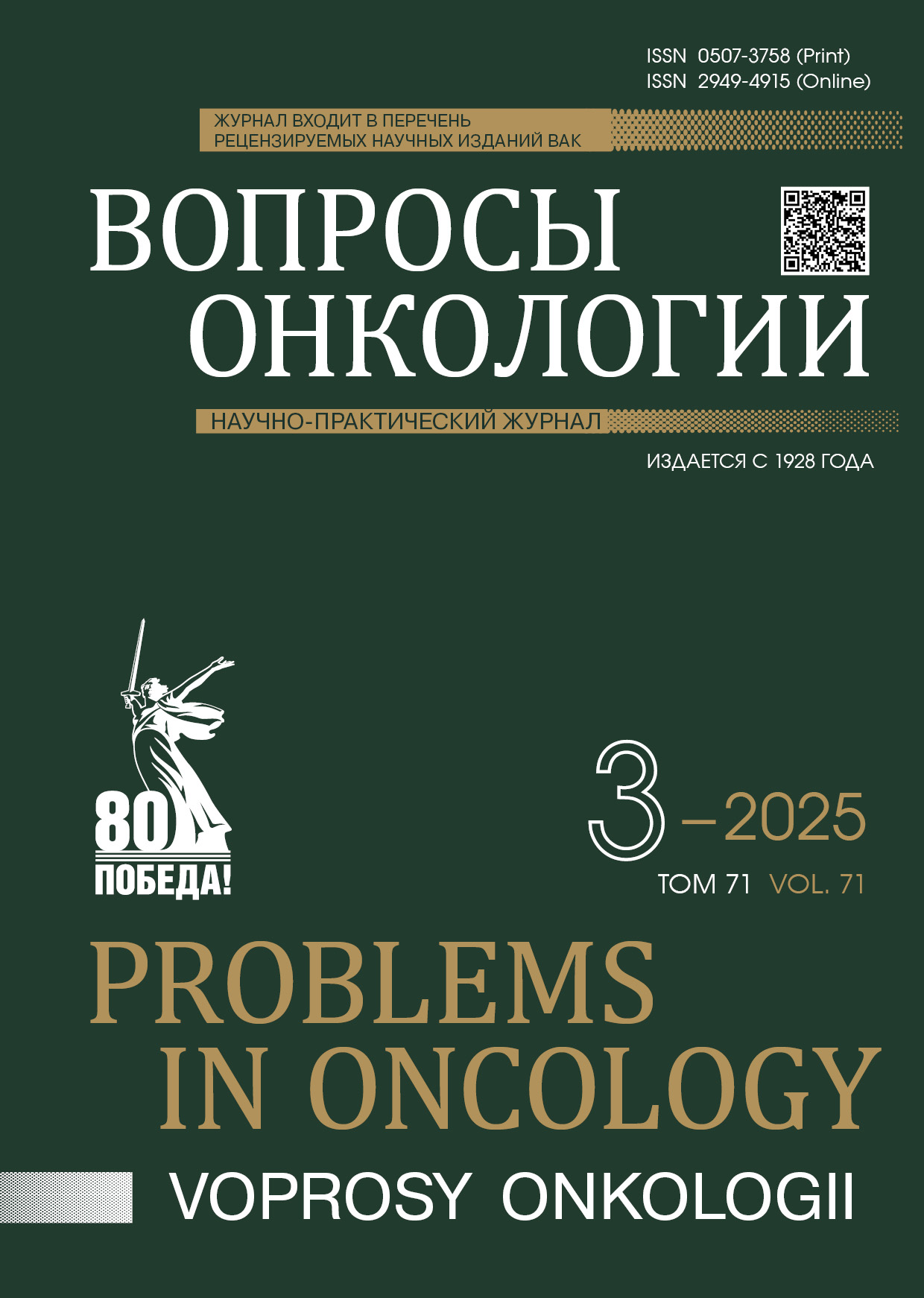Abstract
Introduction. Breast cancer (BC) is the most prevalent oncological disease. Despite the advances in modern approaches to diagnosing and treating early-stage BC, some patients still develop recurrences and metastases. To date, there are no precise methods of determining risk groups for such outcomes. Recommendations for management are therefore based on statistical survival data from different observation groups. We hypothesized that the risks of BC progression are closely related to insufficient immune system function. A promising area of research into immunodeficiency states is the analysis of T- and B-lymphocyte DNA fragments (TREC and KREC) that remain after these cells mature.
Aim. To determine the level of TREC in the blood of patients with and without recurrence in the luminal subtype of BC.
Materials and Methods. The study included 196 patients with luminal HER2-negative BC in stages I–III. Venous blood samples were analyzed to determine TREC and KREC levels. A quantitative analysis of TREC and KREC was performed using an "IMMUNO-BIT" reagent kit. The Real-Time CFX96 Amplifier (Bio-Rad Laboratories, USA) and the DT-96 Detector Amplifier (DNA Technology, Russia) were used as the analyzers. Statistical analysis was performed using StatTech v. 4.6.1 (developer: StatTech LLC, Russia).
Results. The median TREC level was 22.43 in the non-recurrence group, and 3.0 copies per 10^5 cells in the recurrence group (p < 0.001). The study results showed a significant decrease in TREC levels in the blood of patients with further progression. This was interpreted as a deficiency in the T-cell compartment, which plays a key role in controlling tumor growth.
Conclusion. The obtained data support the view that BC may be an immune-mediated oncological disease characterized by reduced immune system activity. Therefore, assessing TREC levels during adjuvant therapy could identify patients at risk of recurrence.
References
Семиглазов В.Ф., Криворотько П.В., Семиглазова Т.Ю., et al. I Санкт-Петербургский международный консенсус по диагностике и лечению рака молочной железы «Белые ночи 2024». Вопросы онкологии. 2024; 70(6): 1175–1188.-DOI: 10.37469/0507-3758-2024-70-6-OF-2194. [Vladimir F. Semiglazov, Petr V. Krivorotko, Tatiana Yu. Semiglazova, et al. 1st Saint Petersburg International Consensus on the Diagnosis and Treatment of Breast Cancer “White Nights 2024”. Voprosy Onkologii = Problems in Oncology. 2024; 70(6): 1175–1188.-DOI: 10.37469/0507-3758-2024-70-6-OF-2194 (In Rus)].
Султанбаев А.В., Колядина И.В., Гилязова И.Р., et al. Наследственные формы злокачественных новообразований молочных желез: прогноз, скрининг и профилактика. Обзор литературы. Современная онкология. 2024; 26(1): 48–55.-DOI: 10.26442/18151434.2024.1.202656. [Sultanbaev A.V., Kolyadina I.V., Gilyazova I.R., et al. Hereditary forms of breast malignant neoplasms: prognosis, screening and prevention. A review. Journal of Modern Oncology. 2024; 26(1): 48–55.-DOI: 10.26442/18151434.2024.1.202656 (In Rus)].
Колядина И.В. Эскалация адъювантной эндокринотерапии раннего гормонозависимого HER2-отрицательного рака молочной железы: кому, когда и зачем? Опухоли женской репродуктивной системы. 2024; 20(1): 89–103.-DOI: 10.17650/1994-4098-2024-20-1-89-103.
[Kolyadina I.V. Escalation of adjuvant endocrine therapy for early hormone-dependent HER2-negative
breast cancer: to whom, when and why? Opukholi zhenskoy reproduktivnoy systemy = Tumors of Female Reproductive
System. 2024; 20(1): 89–103.-DOI: 10.17650/1994-4098-2024-20-1-89-103 (In Rus)].
Колядина И.В. По следам SABCS 2022: TOP-16 исследований по раннему раку молочной железы, которые могут изменить нашу клиническую практику. Современная онкология. 2023; 25(1): 35–45.-DOI: 10.26442/18151434.2023.1.202053. [Kolyadina I.V. Following in the footsteps of SABCS 2022: top 16 early breast cancer studies that could change our clinical practice: A review. Journal of Modern Oncology. 2023; 25(1): 35–45.-DOI: 10.26442/18151434.2023.1.202053 (In Rus)].
Curigliano G., Burstein H.J., Gnant M., et al. Understanding breast cancer complexity to improve patient outcomes: The St Gallen International Consensus Conference for the Primary Therapy of Individuals with Early Breast Cancer 2023. Annals of Oncology. 2023; 34(11): 970–986.-DOI: 10.1016/j.annonc.2023.08.017.
Sorokina I., Ignatieva M., Kolyadina I.V., et al. Therapy decision-making after pre-operative endocrine therapy in HR+ HER2- early breast cancer. Journal of Clinical Oncology. 2023; 41(16_suppl): e12520 .-DOI: 10.1200/JCO.2023.41.16_suppl.e1252.
Морозов Д.А., Колядина И.В., Ганьшина И.П., et al. Особенности ответа на неоадъювантную химиотерапию у больных с агрессивными биологическими подтипами рака молочной железы II–III стадий (оригинальное исследование). Злокачественные опухоли. 2021; 11(4): 5-13. DOI: 10.18027/2224-5057-2021-11-4-5-13. [Morozov D.A., Kolyadina I.V., Ganshina I.P., et al. Characteristics of response to neoadjuvant chemotherapy in patients with aggressive biological subtypes of stage II–III breast cancer. Original study. Malignant Tumors.
; 11(4): 5-13. DOI: 10.18027/2224-5057-2021-11-4-5-13 (In Rus.)].
Султанбаев А.В., Мусин Ш.И., Меньшиков К.В., et al. Стратегия усиления специфического противоопухолевого иммунитета у больных с меланомой. Эффективная фармакотерапия. 2024; 20(5): 116–121.-DOI: 10.33978/2307-3586-2024-20-5-116-121. [Sultanbaev A.V., Musin Sh.I., Menshikov K.V., et al. Strategy for enhancing specific antitumor immunity in patients with melanoma. Effective pharmacotherapy. 2024; 20 (5): 116–121.-DOI 10.33978/2307-3586-2024-20-5-116-121 (In Rus)].
Султанбаев А.В., Тузанкина И.А., Мусин Ш.И., et al. Специфический противоопухолевый иммунитет и механизмы ускользания опухоли от иммунологического надзора. Онкология. Журнал им. П.А. Герцена. 2024; 13(6): 70–77. [Sultanbaev A.V., Tuzankina I.A., Musin Sh.I., et al. Specific antitumour immunity and mechanisms of tumour escape from immunological surveillance. P.A. Herzen Journal of Oncology. 2024; 13(6): 70-77.-DOI: 10.17116/onkolog20241306170 (In Rus)].
Sultanbaev A.V., Kolyadina I.V., Sultanbaev M., et al. Options for enhancing specific antitumor immunity in patients with melanoma. Journal of Clinical Oncology. 2024; 42(16_suppl): e21547.
Chang S.T., Chuang Y.F., Li A.H., et al. Age-dependent immune profile in healthy individuals: an original study, systematic review and meta-analysis. Immunity & Ageing. 2024; 21(1): 75.-DOI: 10.1186/s12979-024-00480-x.
Hong H., Wang Q., Li J., et al. Aging, cancer and immunity. Journal of Cancer. 2019; 10(13): 3021–3027.-DOI: 10.7150/jca.30723.
Давыдова Н.В., Продеус А.П., Образцов И.В., et al. Референсные значения концентрации TREC и KREC у взрослых. Врач. 2021; 32(6): 21–28. -DOI: 10.29296/25877305-2021-06-05.
[Davydova N.V., Prodeus A.P., Obraztsov I.V., et al. Reference values for TREC and KREC concentrations in adults. Vrach. 2021; 32(6): 21-28.-DOI: 10.29296/25877305-2021-06-05 (In Rus)].
Chen F., Tang H., Cai X., et al. DAMPs in immunosenescence and cancer. Seminars in Cancer Biology. 2024; 106-107: 123–142.-DOI: 10.1016/j.semcancer.2024.09.005.
Huang M., Wang Y., Fang L., et al. T cell senescence: a new perspective on immunotherapy in lung cancer. Frontiers in Immunology. 2024; 15: 1338680.-DOI: 10.3389/fimmu.2024.1338680.

This work is licensed under a Creative Commons Attribution-NonCommercial-NoDerivatives 4.0 International License.
© АННМО «Вопросы онкологии», Copyright (c) 2025

